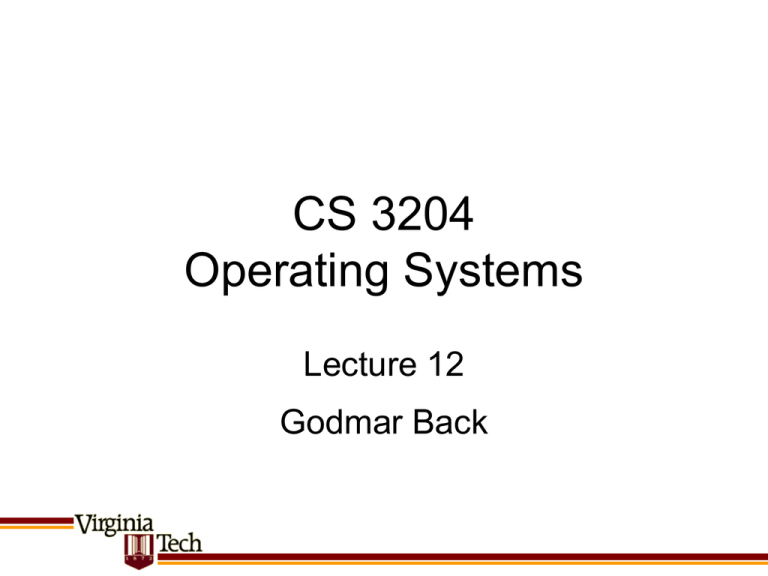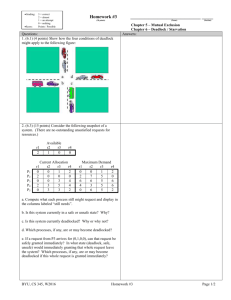ppt
advertisement

CS 3204
Operating Systems
Lecture 12
Godmar Back
Announcements
• Project 2 due Oct 20
– Should have initial steps in 3.2 Suggested Order of
Implementation by about now, but completed no later than Oct
8.
• Will return midterm on Thursday
• Office Hours this week:
– Back on Wed 2pm-4pm
– Ryan on Wed 4pm-6pm
– No hours on Thursday
CS 3204 Fall 2008
3/22/2016
2
Deadlock
Deadlock (Definition)
• A situation in which two
or more threads or
processes are blocked
and cannot proceed
• “blocked” either on a
resource request that
can’t be granted, or
waiting for an event that
won’t occur
– Possible causes: resourcerelated or communicationrelated
• Cannot easily back out
CS 3204 Fall 2008
3/22/2016
4
Deadlock Canonical Example (1)
pthread_mutex_t A;
pthread_mutex_t B;
…
pthread_mutex_lock(&A);
pthread_mutex_lock(&B);
…
pthread_mutex_unlock(&B);
pthread_mutex_unlock(&A);
pthread_mutex_lock(&B);
pthread_mutex_lock(&A);
…
pthread_mutex_unlock(&A);
pthread_mutex_unlock(&B);
A
B
Thread 1
Thread 2
CS 3204 Fall 2008
3/22/2016
5
Canonical Example (2)
account acc1(10000, "acc1");
account acc2(10000, "acc2");
// Thread 1:
for (int i = 0; i < 100000; i++)
class account {
acc2.transferTo(&acc1, 20);
pthread_mutex_t lock; // protects balance
// Thread 2:
int balance; const char *name;
for (int i = 0; i < 100000; i++)
public:
acc1.transferTo(&acc2, 20);
account(int balance, const char *name) :
balance(balance), name(name) { pthread_mutex_init(&this->lock, NULL); }
void transferTo(account *that, int amount) {
pthread_mutex_lock(&this->lock);
pthread_mutex_lock(&that->lock);
cout << "Transferring $" << amount << " from "
<< this->name << " to " << that->name << endl;
this->balance -= amount;
that->balance += amount;
pthread_mutex_unlock(&that->lock);
Q.: How to fix?
pthread_mutex_unlock(&this->lock);
}
};
CS 3204 Fall 2008
3/22/2016
6
Canonical Example (2, cont’d)
• Answer: acquire locks in same order
void transferTo(account *that, int amount) {
if (this < that) {
pthread_mutex_lock(&this->lock);
pthread_mutex_lock(&that->lock);
} else {
pthread_mutex_lock(&that->lock);
pthread_mutex_lock(&this->lock);
}
/* rest of function */
}
CS 3204 Fall 2008
3/22/2016
7
Reusable vs. Consumable Resources
• Distinguish two types of resources when discussing
deadlock
• A resource:
– “anything a process needs to make progress”
– But must be something that can be counted in units
• (Serially) Reusable resources (static, concrete, finite)
– CPU, memory, locks
– Can be a single unit (CPU on uniprocessor, lock), or multiple
units (e.g. memory, semaphore initialized with N)
• Consumable resources (dynamic, abstract, infinite)
– Can be created & consumed: messages, signals
• Deadlock may involve reusable resources or
consumable resources
CS 3204 Fall 2008
3/22/2016
8
Consumable Resources & Deadlock
void client() {
for (i = 0; i < 10; i++)
send(request[i]);
for (i = 0; i < 10; i++) {
receive (reply[i]);
send(ack);
}
}
void server() {
while (true) {
receive(request);
process(request);
send(reply);
receive(ack);
}
}
• Assume client & server communicate using 2 bounded
buffers (one for each direction)
– Real-life example: flow-controlled TCP
• Q.: Under what circumstances does this code deadlock?
CS 3204 Fall 2008
3/22/2016
9
Deadlocks, more formally
•
•
•
4 necessary conditions
1)
2)
3)
4)
–
Exclusive Access
Hold and Wait
No Preemption
Circular Wait
R1
P1
R3
P2
P3
P4
Aka Coffman conditions
Note that cond 1-3 represent things
R2 that areR4
normally desirable or required
Will look at strategies to
–
–
–
Detect & break deadlocks
Prevent
Avoid
CS 3204 Fall 2008
Resource Allocation Graph
R → P Assignment
P → R Request
3/22/2016
10
Deadlock Detection
• Idea: Look for circularity in resource allocation graph
– Q.: How do you find out if a directed graph has a cycle?
• Can be done eagerly
– on every resource acquisition/release, resource allocation graph
is updated & tested
• or lazily
– when all threads are blocked & deadlock is suspected, build
graph & test
• Windows provides this for its mutexes as an option
• Note: all processes in BLOCKED state is not sufficient to
conclude existence of deadlock. (Why?)
• Note: circularity test is only sufficient criteria if there’s
only a single instance of each resource – see next slide
for multi-unit resources
CS 3204 Fall 2008
3/22/2016
11
Multi-Unit Resources
R3
R1
P1
Resource Allocation Graph
R → P Assignment
P → R Request
Resource Unit
P2
R2
P3
P4
R4
• Note: Cycle, but no deadlock!
CS 3204 Fall 2008
3/22/2016
12
Deadlock Detection
• For reusable resources
– If each resource has exactly one unit, deadlock iff
cycle
– If each resource has multiple units, existence of cycle
may or may not mean deadlock
• Must use reduction algorithm to determine if deadlock exists
(Intuition: remove processes that don’t have request edges,
return their resource units and remove assignment edges,
assign resources to remove request edges, repeat until out of
processes without request edges. – If entire graph reduces to
empty graph, no deadlock.)
• For consumable resources
– analog algorithm possible
• Q.: What to do once deadlock is detected?
CS 3204 Fall 2008
3/22/2016
13
Increasing Severity
Deadlock Recovery
• Preempt resources (if possible)
• Back processes up to a checkpoint
– Requires checkpointing or transactions
(typically expensive)
• Kill processes involved until deadlock
is resolved
• Kill all processes
involved
• Reboot
CS 3204 Fall 2008
3/22/2016
14
Killing Threads or Processes
• Can be difficult issue:
– When is it safe to kill a thread/process?
• Consider:
thread_func()
{
while (!done) {
lock_acquire(&lock);
// access shared state
lock_release(&lock);
}
}
•
What if
thread is
killed
here?
thread_func()
{
while (!done) {
lock_acquire(&lock);
p = queue1.get();
queue2.put(p);
lock_release(&lock);
}
}
Must guarantee
• full resource reclamation (e.g., locks held must be unlocked)
• consistency of all surviving system data structures (e.g., no packets
dropped)
CS 3204 Fall 2008
3/22/2016
15
Safe Termination
• System code must make sure that no shared
data structures are left in an inconsistent state
when thread is terminated
– Same assurance must hold even if thread terminates
itself (as in Pintos project 2)
• General strategy:
– Allow termination of user processes at any point in
time
• Note: this does not protect user’s data structures
– Restrict kernel code to certain termination points
(where process checks if termination request is
pending):
• E.g., after schedule(); before returning from syscall
• Protects kernel’s data structures
CS 3204 Fall 2008
3/22/2016
16
Deadlock Prevention (1)
• Idea: remove one of the necessary conditions!
• (C1) (Don’t require) Exclusive Access
– Duplicate resource or make it shareable (where
possible)
• (C2) (Avoid) Hold and Wait
– a) Request all resources at once
• hard to know in modular system
– b) Drop all resources if additional request cannot be
immediately granted – retry later
• requires “try_lock” facility
• can be inefficient if lots of retries
CS 3204 Fall 2008
3/22/2016
17
Deadlock Prevention (2)
• (C3) (Allow) Preemption
– Take resource away from process
• Difficult: how should process react?
– Virtualize resource so it can be taken away
• Requires saving & restoring resource’s state
• (C4) (Avoid) Circular Wait
– Use partial ordering
• Requires mapping to domain that provides an
ordering function (addresses often work!)
CS 3204 Fall 2008
3/22/2016
18
Deadlock Avoidance
• Don’t grant resource request if deadlock could occur in
future
– Or don’t admit process at all
• Banker’s Algorithm (Dijkstra 1965, see book)
– Avoids “unsafe” states that might lead to deadlock
– Need to know what future resource demands are (“credit lines” of
all customers)
– Need to capture all dependencies (no additional synchronization
requirements – “loans” can be called back if needed)
• Mainly theoretical
– Impractical assumptions
– Tends to be overly conservative – inefficient use of resources
CS 3204 Fall 2008
3/22/2016
19
Deadlock In The Real World
CS 3204 Fall 2008
3/22/2016
20
Deadlock in the Real World
• Most common strategy of handling deadlock
– Test: fix all deadlocks detected during testing
– Deploy: if deadlock happens, kill and rerun (easy!)
• If it happens too often, or reproducibly, add deadlock
detection code
• Weigh cost of preventing vs cost of (re-)
occurring
• Static analysis tools detects some kinds of
deadlocks before they occur
– Example: Microsoft Driver Verifier
– Idea: monitor order in which locks are taken, flag if
not consistent lock order
CS 3204 Fall 2008
3/22/2016
21
Deadlock vs. Starvation
• Deadlock:
– No matter which policy the scheduler chooses,
there is no possible way for processes to make
forward progress
• Starvation:
– There is a possible way in which threads can
make possible forward progress, but the
scheduler doesn’t choose it
• Example: strict priority scheduler will never scheduler
lower priority threads as long as higher-priority thread is
READY
• Example: naïve reader/writer lock: starvation may occur
by “bad luck”
CS 3204 Fall 2008
3/22/2016
22
Informal uses of term `deadlock’
• 4 Coffman conditions apply specifically to deadlock
with definable resources
• Term deadlock is sometimes informally used to also
describe situations in which not all 4 criteria apply
– See interesting discussion in Levine 2003, Defining
Deadlock
– Consider: When two trains approach each other at a
crossing, both shall come to a full stop and neither shall
start up again until the other has gone.
– Does it meet the 4 conditions?
• However, even under informal/extended view, not all
“lack of visible progress” situations can reasonably be
called deadlocked
– e.g., an idle system is not usually considered deadlocked
CS 3204 Fall 2008
3/22/2016
23
Summary
• Deadlock:
– 4 necessary conditions: mutual exclusion,
hold-and-wait, no preemption, circular wait
• Strategies to deal with:
– Detect & recover
– Prevention: remove one of 4 necessary
conditions
– Avoidance: if you can’t do that, avoid
deadlock by being conservative
CS 3204 Fall 2008
3/22/2016
24





